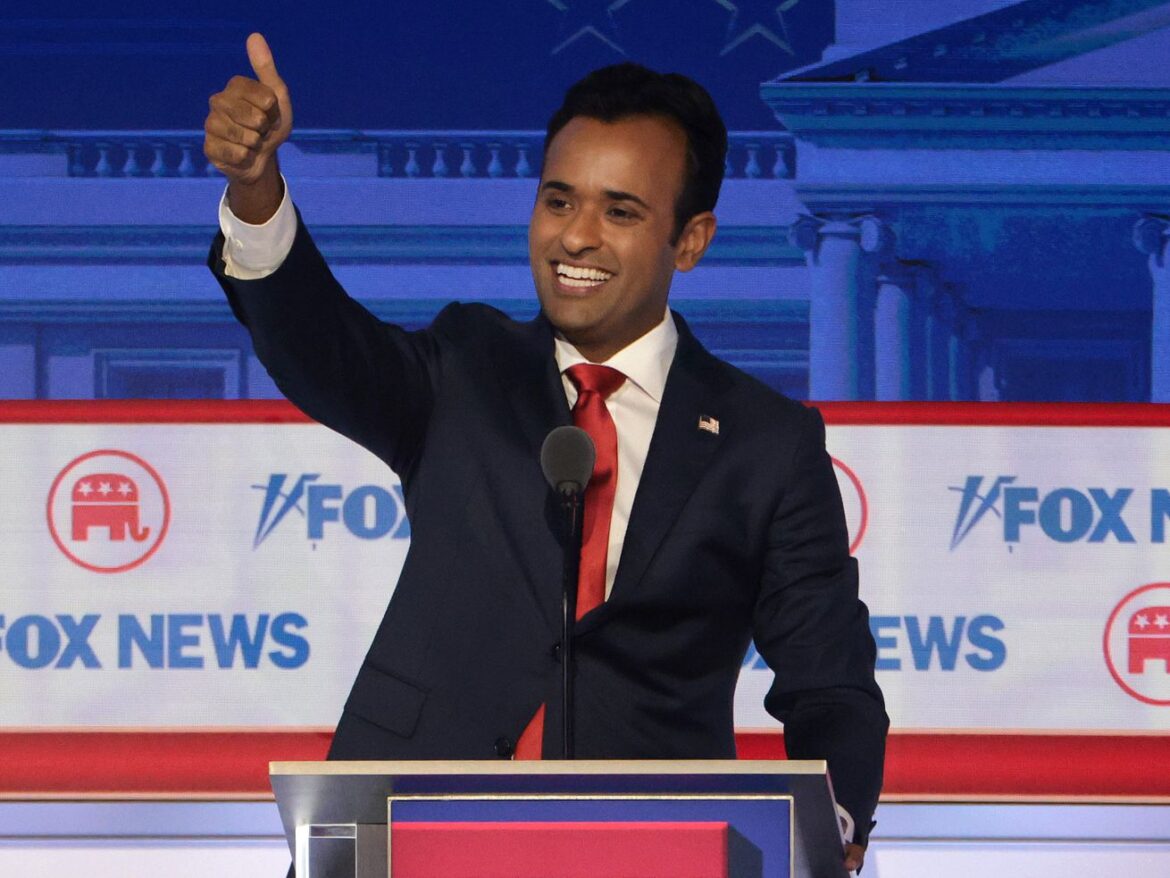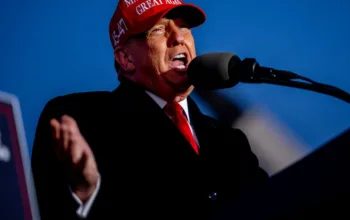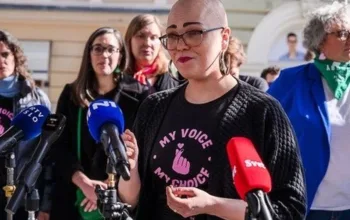The Asian American candidate is peddling a dangerous message.
When Vivek Ramaswamy opened the first GOP presidential primary debate last month, he acknowledged that he does not fit the mold of a traditional Republican presidential candidate. “Let me just address the question that is on everybody’s mind at home tonight,” he said. In a line he lifted from Barack Obama, he continued: “Who the heck is this skinny guy with a funny last name, and what the heck is he doing in the middle of this debate stage?”
Ramaswamy, 38, is an outlier within the ranks of the GOP: He is the son of immigrants, Hindu, brown-skinned, and under 40. He belongs to a demographic that overwhelmingly skews Democratic and is often targeted by Republican policies. Even if Ramaswamy is unlikely to win the nomination, in a few weeks, he has made an impact: He briefly climbed ahead of prominent career politicians, including Mike Pence, Nikki Haley, Tim Scott, and Chris Christie, to third place in the Republican primary polls. He is a near-ubiquitous presence in the media, and, in the aftermath of the first debate, Google registered more than a million searches for “Vivek Ramaswamy” in 24 hours, while Donald Trump dubbed him the debate’s winner. (Ramaswamy has called Trump “the best president of the 21st century.”)
It would be a mistake to dismiss the curious rise of Ramaswamy as a fluke. The multimillionaire venture capitalist is a Trojan horse: He represents a younger, more racially diverse generation, yet espouses the same ultra-conservative, right-wing ideology of 77-year-old Donald Trump, and he embodies the ethos of the “self-made” business mogul that Trump’s base loves. As conservative New York Times columnist Ross Douthat put it, “His two personae — as the son of immigrants defending capitalism and meritocracy and the policy entrepreneur promising that you can defeat wokeness by remaking the federal civil rights bureaucracy — indicate the ground where an important part of the right wants to fight its battles.”
At the core of those personae and at the root of Ramaswamy’s appeal is the pernicious “model minority” stereotype — a story about self-sufficiency and innate talent woven around the creation of an Asian American professional class in the 1960s — that has since been used to dismantle civil rights, divide communities of color, and perpetuate the myth of America as colorblind. (Vox sent an email to Ramaswamy’s campaign seeking comment about the model minority myth; campaign spokesperson Tricia McLaughlin responded only, “What is the model minority myth?” and did not reply to a follow-up email.)
The sudden visibility of an Indian American man in a party of mostly white conservatives illustrates how that image of the so-called model minority can be manipulated to broaden the appeal of Asian American candidates within a predominantly white Republican base. It may also provide a new roadmap to other Asian Americans and people of color angling to rise within the GOP.
Ramaswamy’s hard-to-pin-down beliefs stem from an “unapologetic embrace of meritocracy in the pursuit of excellence,” as he told USA Today. He told Vox in August: “I think everything should be more of a meritocracy. You get ahead and achieve your own God-given potential, whatever that is, in a way that’s unconstrained by any obstacles put in your way.”
He positions his own ability to attract investors and fulfill the American dream as the reason he is electable and qualified to lead the country. “My parents came to this country with no money 40 years ago,” Ramaswamy said during the debate. “I have gone on to found multibillion-dollar companies. I did it while marrying my wife Apoorva, raising our two sons, following our faith in God. That is the American dream.” Ramaswamy uses his ability to secure that dream as a means to justify oppression and deny the existence of systemic racism. In his book Nation of Victims, Ramaswamy writes that there was once a time when racism was so pervasive that it “demanded a comprehensive societal response.” But that era has ended, he argues, and Black Americans have become “the gold standard of constitutional victimhood.”
He has called affirmative action “a cancer on our national soul,” considers Juneteenth “useless,” opposes trans and abortion rights, believes that climate change is a hoax, and rails against “wokeism.” He proposes stripping the government of all social welfare or oversight. Rather than examining why — or how — a family of Indian immigrants succeeded despite America’s expansive racial wealth gap and staggering inequality, Ramaswamy uses his privilege to explain them away.
Deploying the model minority stereotype demands a forgetting of American history. From the late 1800s until the mid-1960s, immigration from Asia was outright banned or severely limited. (Ramaswamy’s ancestors would have been regarded as “Dusky Peril.”) During the Cold War and amid the civil rights movement, American leaders felt pressured to appear as a true democracy on the world stage. Legislators passed the landmark Hart-Celler Immigration Act of 1965 and began admitting immigrants with high education levels, strong family ties, and specialized skills — many from Asia’s professional classes. White public intellectuals pointed to upwardly mobile Asian Americans and made a sweeping generalization: that Asians are hard-working, have tight-knit families, are inherently successful, and are politically docile. This flattening image of the model minority —which is also psychologically and socially damaging for Asian Americans — portrays success as an inherent ethnic trait while enabling the very racial exclusion it claims has ended.
Indian Americans like Ramaswamy, who is Hindu and Brahmin, have gained prominence within the context of this myth: In a little over a generation, Indians have emerged as the wealthiest and most educated immigrant group in the country. The story of this subcommunity’s outlier success fuels the trope Republican Georgia Rep. Rich McCormick summarized in remarks about his Indian constituents to Congress in January: “They are amongst the top producers, and they do not cause problems. They follow laws. They don’t have the problems that we see other people have … because they’re the most productive, most family-oriented, and the best of what represents American citizens.”
The extraordinary success of Indian Americans is not simply a result of immigrant grit or natural talent, as people like Ramaswamy or McCormick portray it to be. According to the book The Other One Percent: Indians in America, the Indian American diaspora has been shaped, in large part, by an invisible but rigorous form of social stratification: People from the highest classes and castes in India — Brahmins being at the top — are most likely to access the best schools and jobs, feeding into an American immigration system that selects privileged immigrants into white-collar jobs.
Ramaswamy embodies the troubling phenomenon that can follow. As novelist Sanjena Sathian wrote in Time, “Indian Americans from my subculture — usually wealthy, dominant-caste Hindus — often actively embrace stories casting ourselves as America’s great successes, as the outsiders who confirm the meritocratic American dream.” Overlooking these hidden social privileges contributes to false notions that America is a nation where anyone can rise simply through hard work, and that people of color do not face barriers to success.
Exceptionalism is alluring because it can offer immigrants and their children a sense of safety. In a country that regards Asian Americans as perpetually foreign, the perception of appearing innately successful, hard-working, and high-achieving can help one feel more accepted.
But this myth obscures a complex reality: that Asian Americans — a broad group that encompasses more than 20 million people and 24 countries of origin — also suffer the deepest income inequality of any ethnic group; that Asian American young adults are the only racial group whose leading cause of death is suicide; that Asian Americans have faced a spike in racist violence; and that even economic success does not lift barriers in corporate America, where Asian Americans are the racial group least likely to be promoted to management. Embracing the fable of “model” minorities renders it nearly impossible to address these inequalities, because it argues that Asian Americans are immune to struggle.
Ramaswamy is not the first Indian American — nor Asian American — Republican political candidate to invoke the stereotype, or to center his electability around the idea of meritocracy. But Ramaswamy has created “a model minority myth frame that’s modernized and updated to our current period,” observes Karthick Ramakrishnan, a public policy and political science professor at University of California Riverside and founder of AAPI Data, which publishes demographic data and policy research about Asian Americans and Pacific Islanders.
Ramaswamy is leaping off a platform that Donald Trump built; the idea “that you don’t need prior political experience — and in fact, prior political experience is a liability, not an asset — and a ‘self-made’ multimillionaire has more to offer than someone who has significant government experience,” Ramakrishnan says. In doing so, Ramaswamy may be creating a new mold for a certain type of ambitious, affluent Asian American within the Republican Party. “Ramaswamy’s primary audience is white voters, because that’s where the votes are,” Ramakrishnan says. His popularity among that demographic strengthens a dangerous stereotype about Asian Americans and asserts it to gut civil rights for everyone.
After decades of invisibility, Asian American political power is growing rapidly. Asian American buying power is increasing at a faster rate than that of other racial minority groups, and they are the fastest-growing group in the country. As recent elections in swing states such as Georgia suggest, while Asian Americans represent a small share of the national population, their turnout can shift elections. “As the past few years have shown us, Asian American political mobilization is becoming increasingly consequential,” displaying “the willpower to disrupt the status quo of American politics,” says Ellen Wu, an Indiana University Bloomington history professor and the author of The Color of Success: Asian Americans and the Origins of the Model Minority.
But will the rising influence of Asian Americans become a way to dismantle stereotypes and unite communities of color? Or will it, instead — as is evident in Ramaswamy’s origin myth — become a way to reinforce America’s existing racial hierarchy? As University of Maryland professor and political scientist Janelle Wong told NPR, “Asian Americans who internalize [the model minority] myth are also more likely to exhibit anti-Black attitudes and to be anti-affirmative action.”
Asian Americans, Wu notes, are “the wild card of US race relations.”
Republicans have long weaponized the model minority myth to attempt to divide communities of color and pitch Asian Americans as white-adjacent. A few months ago, Florida Gov. Ron DeSantis called for teaching Asian American history in Florida — an area of history oft-overlooked in classrooms — but banned critical race theory from schools, and rejected the AP African American History course in another effort to divide Asian Americans and Black Americans. (Yet “Asian American” itself is a racial construct that cannot be understood without the insights of critical race theory.)
After his failed attempt to challenge affirmative action with the case of Abigail Fisher, a white applicant, conservative activist Ed Blum realized, “I needed Asian plaintiffs.” His latest challenge, led by Asian American plaintiffs, succeeded in undoing landmark civil rights legislation. (Blum has set his sights on diversity initiatives in the workplace next.) During last year’s elections in California, where 15 percent of the population identifies as Asian American, executive director of left-leaning alliance Asian American Power Network Nadia Belkin told the Washington Post that Republican campaigns were “pulling the Asian American community towards them” and even made some voters “feel seen in a way that progressives have not.”
Ramaswamy gives efforts like these a more welcoming face, carving a path for Republicans to stay relevant in America’s increasingly racially diverse landscape without ever having to change or shift their ideologies. Voters ought to be wary of Ramaswamy’s eagerness to tout his exceptional upbringing and the GOP’s willingness to embrace it as the truth. It’s a strategy that dismantles opportunity under the guise of creating more.
Prachi Gupta is an award-winning journalist with bylines in the Atlantic, the Washington Post Magazine, Jezebel, and elsewhere. She is the author of the memoir They Called Us Exceptional: And Other Lies That Raised Us, which explores the psychological harms of the model minority myth.



